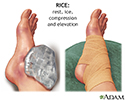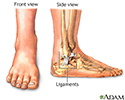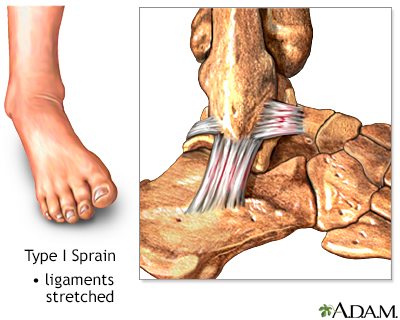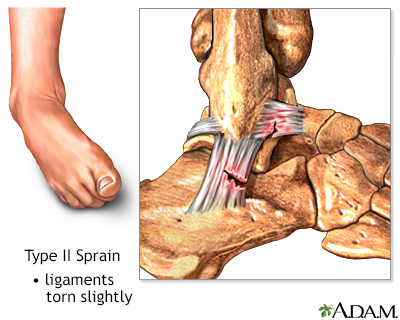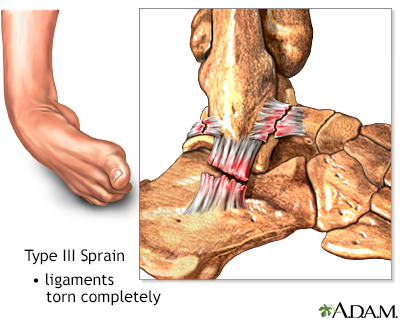Sprains
Joint sprainA sprain is an injury to the ligaments around a joint. Ligaments are strong, flexible fibers that hold bones together. When a ligament is stretched too far or tears, the area around the joint will become painful and swell.
Causes
Sprains are caused when a joint is forced to move into an unnatural position. For example, "twisting" one's ankle causes a sprain to the ligaments around the ankle.
Symptoms
Symptoms of a sprain include:
- Joint pain or muscle pain
Muscle pain
Muscle aches and pains are common and can involve more than one muscle. Muscle pain also can involve ligaments, tendons, and fascia. Fascias are th...
 ImageRead Article Now Book Mark Article
ImageRead Article Now Book Mark Article - Swelling
Swelling
Swelling is the enlargement of organs, skin, or other body parts. It is caused by a buildup of fluid in the tissues. The extra fluid can lead to a ...
 ImageRead Article Now Book Mark Article
ImageRead Article Now Book Mark Article - Joint stiffness
- Discoloration of the skin, especially bruising
Bruising
Bleeding into the skin can occur from broken blood vessels that form tiny red dots (called petechiae). Blood also can collect under the tissue in la...
 ImageRead Article Now Book Mark Article
ImageRead Article Now Book Mark Article
First Aid
First aid steps include:
- Apply ice right away to reduce swelling. Wrap the ice in cloth. Do not place ice directly on the skin.
- Wrap a bandage around the affected area to limit movement. Wrap firmly, but not tightly. Use a splint if needed.
Splint
A splint is a device used to hold a part of the body stable to decrease pain and prevent further injury.
 ImageRead Article Now Book Mark Article
ImageRead Article Now Book Mark Article - Keep the swollen joint raised above your heart, even while sleeping.
- Rest the affected joint for several days.
- Avoid putting stress on the joint because it can make the injury worse. A sling for the arm, or crutches or a brace for the leg can protect the injury.
Crutches
It is important to start walking as soon as you can after your surgery. But you will need support for walking while your leg heals. Crutches may be...
Read Article Now Book Mark Article
Aspirin, ibuprofen, or other pain relievers can help. DO NOT give aspirin to children.
Keep pressure off the injured area until the pain goes away. Most of the time, a mild sprain will heal in 7 to 10 days. It may take several weeks for pain to go away after a bad sprain. Your health care provider may recommend crutches. Physical therapy can help you regain motion and strength of the injured area.
When to Contact a Medical Professional
Go to the hospital right away or call 911 or the local emergency number if:
- You think you have a broken bone.
Broken bone
If more pressure is put on a bone than it can stand, it will split or break. A break of any size is called a fracture. If the broken bone punctures...
 ImageRead Article Now Book Mark Article
ImageRead Article Now Book Mark Article - The joint appears out of position.
- You have a serious injury or severe pain.
- You hear a popping sound and have immediate problems using the joint.
Contact your provider if:
- Swelling does not start to go away within 2 days.
- You have symptoms of infection, including red, warm, painful skin or a fever over 100°F (38°C).
- The pain does not go away after several weeks.
Prevention
The following steps may lower your risk for a sprain:
- Wear protective footwear during activities that place stress on your ankle and other joints.
- Make sure that shoes fit your feet properly.
- Avoid high-heeled shoes.
- Always warm-up and stretch before doing exercise and sports.
- Avoid sports and activities for which you have not trained.
References
Biundo JJ. Bursitis, tendinitis, and other periarticular disorders and sports medicine. In: Goldman L, Schafer AI, eds. Goldman-Cecil Medicine. 26th ed. Philadelphia, PA: Elsevier; 2020:chap 247.
Geiderman JM, Torbati S. General principles of orthopedic injuries. In: Walls RM, ed. Rosen's Emergency Medicine: Concepts and Clinical Practice. 10th ed. Philadelphia, PA: Elsevier; 2023:chap 41.
Wang D, Eliasberg CD, Rodeo SA. Physiology and pathophysiology of musculoskeletal tissues. In: Miller MD, Thompson SR. eds. DeLee, Drez, & Miller's Orthopaedic Sports Medicine. 5th ed. Philadelphia, PA: Elsevier; 2020:chap 1.
Early treatment of injury - illustration
Minor injuries like sprains may be treated at home if broken bones are not suspected. The acronym RICE is helpful in remembering how to treat minor injuries R stands for rest, I is for ice, C is for compression, and E is for elevation. Pain and swelling should decrease within 48 hours, and gentle movement may be beneficial, but pressure should not be put on a sprained joint until pain is completely gone (one to several weeks).
Early treatment of injury
illustration
Ankle sprain - Series
Presentation
Early treatment of injury - illustration
Minor injuries like sprains may be treated at home if broken bones are not suspected. The acronym RICE is helpful in remembering how to treat minor injuries R stands for rest, I is for ice, C is for compression, and E is for elevation. Pain and swelling should decrease within 48 hours, and gentle movement may be beneficial, but pressure should not be put on a sprained joint until pain is completely gone (one to several weeks).
Early treatment of injury
illustration
Ankle sprain - Series
Presentation
Review Date: 4/27/2023
Reviewed By: Linda J. Vorvick, MD, Clinical Professor, Department of Family Medicine, UW Medicine, School of Medicine, University of Washington, Seattle, WA. Also reviewed by David C. Dugdale, MD, Medical Director, Brenda Conaway, Editorial Director, and the A.D.A.M. Editorial team.


